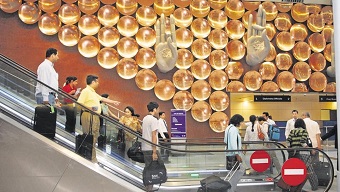Passengers flying out from Delhi’s Indira Gandhi International Airport (IGIA) will have to take off their footwear before the mandatory body scan as part of the security check-in procedure starting in April, according to senior officers from the Central Industrial Security Force (CISF), which secures the Delhi airport. This is because extensive tests conducted on the body scanning machines showed that they did not deliver accurate results below the ankle. The CISF has been testing out the German-made machines since November last year.
Removing footwear is a practice in several airports around the world, including several European nations and the United States.
Last June, the Bureau of Civil Aviation Security (BCAS) asked for body scanners to be installed at joint-venture airports, such as the IGIA, by April 2020. Following this, six airports in the country will start the use of body scanners by April, and other government-operated airports will follow suit by April 2021. According to senior officers, the scanner at IGIA has been successful in detecting suspicious and prohibited items. “In 2017, we tested body scanners that were like telephone booths. A passenger had to go in and it would take around 8-10 seconds for the scan. The current one is an open structure with faster scanning,” said an officer with direct knowledge of the trials.
The officer said a few tested passengers complained of feeling claustrophobic in the previous version. “The new scanner is more efficient. Earlier, we could not detect anything above a passenger’s eyes requiring them to take off headgear, be it a turban, hats or caps. The only drawback the current scanner has is that it does not properly detect anything below the ankle, so the passengers will have to take off their footwear.”
Another officer said that the new machine raised fewer false alarms. “The body scanners being tested currently are very precise but no machine can do away with manual intervention. Once it gives us a mannequin image of the passenger we can decide which area needs to be manually checked,” he said. The door-frame detectors, which are in use at Indian airports at the moment, however, will not be completely done away with. “We will still use them for passengers with disability and for those with some medical condition,” the officer said.








